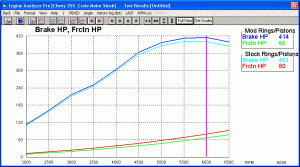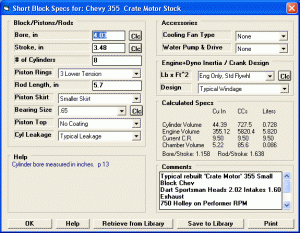Most engine builders only think of producing more power by making modifications which allow the engine to “breath better”. These include bigger carbs, bigger cams, bigger ports, bigger and more cylinders, force feeding via turbos or superchargers. These all involve improving the Volumetric Efficiency of the engine.
The next step to better performance would be more exotic, like higher compression, different fuels, nitrous oxide injection, better combustion chambers, dual spark plugs, which allow the engine to make better use of the air and fuel that is already getting in the engine. These mods deal with improving the Thermal Efficiency* of the engine.
After that, most builders and tuners start to run out of ideas. But there is one more efficiency which can produce large performance improvements and that is improving the Mechanical Efficiency of the engine. Volumetric and Thermal Efficiency produce high pressure on top of the piston and push the piston through it’s stroke. This pressure may produce, say, 500 HP at 6000 RPM. In a perfect world you would get 500 HP at the flywheel. However, the friction of the engine’s internal moving and rubbing parts can reduce this potential HP down to 400 HP at the flywheel. Then you have some accessories like the oil pump and water pump, alternator and cooling fan, and you’re down to 350 HP.
These losses deal with the Mechanical Efficiency of the engine, which means for the gross power that is produced on top of the pistons, how much actually gets to the flywheel. These friction losses are often forgotten until you’ve maxed out the Volumetric and Thermal Efficiency. However, there are substantial gains to be made.
The graph below was done with our Engine Analyzer Pro. It shows that at 6000 RPM an engine that produces about 400 HP after it gets past about 80 HP of internal friction. It also shows a comparison run where we asked the Pro to simulate a smaller piston skirt and lower tension piston rings. It shows about a 14 HP drop in friction which results in a 14 HP gain. And that is produced with NO additional fuel or air being burned. That’s about as close to “a free lunch” or “something for nothing” as you can get.

The screen below shows the Engine Analyzer Pro’s Short Block screen, where you can make many mods to check the effect on engine friction. If you click on the “Clc” button for Bearing Friction Coef, you are presented with a screen that lets you change number of journals, and the journal diameters and widths for the mains, rods and cam. These inputs let you get quite detailed for different mods.
-
Friction mods are typically precise, internal modifications to the engine. These are not cheap and are not “bolt ons”.
-
Typically friction mods reduce the strength of some engine component. If that component was 10 times stronger than needed, no problem. However, if it was only 50% stronger than needed, you may have a problem. The idea is to make all rubbing surfaces as small and/or friction free as needed for your type of racing. Remember the adage “To finish first, you must first finish.”
The graph also shows that the higher the RPM, the more the HP losses. Therefore if you are building a lower RPM street motor, trying to reduce friction would not be the first thing to try. But, if you are building a race motor, where rules severely limit your creativity, reducing friction is a “gold mine” of oportunities.
* Technically the “different fuels, nitrous oxide injection” mods deal with the chemical energy contained in the fuel, and finding oxygen to burn the fuel from some source other than air. These mods could be grouped into the Volumetric Efficiency catagory because they deal with getting more fuel energy and oxygen into the engine, not combusting that energy more efficiently.
